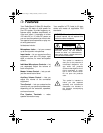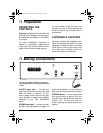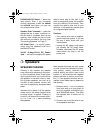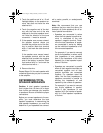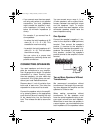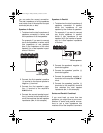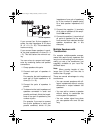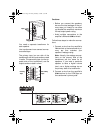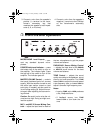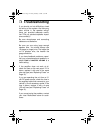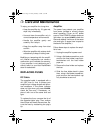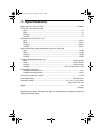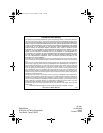
6
3. Touch the positive end of a 1.5-volt
flashlight battery to the speaker ter-
minal that does not have the wire
attached to it.
4. Touch the negative end of the bat-
tery with the lose end of the wire
attached to the other speaker termi-
nal. Note the direction of the cone
movement — inward or outward.
5. If the speaker cone moves outward,
the speaker terminal where you
touched the positive end of the bat-
tery is positive. Mark that terminal
with a + and mark the other terminal
with a –.
If the speaker cone moves inward,
the speaker terminal with the wire
attached that touched the negative
end of the battery is positive. Mark
that terminal with a + and mark the
other terminal with a –.
6. Remove the wire.
Repeat Steps 2–6 for each speaker with
unmarked terminals you plan to connect
to the amplifier.
DETERMINING TOTAL
SPEAKER IMPEDANCE
Caution:
A total speaker impedance
that is higher than 16 ohms (
Ω)
or lower
than 4 ohms can damage your amplifier
or speakers. Be sure to make the proper
connections.
Before you connect speakers to the am-
plifier, you must determine the total
speaker impedance. In determining the
total speaker impedance, you must first
determine if your speakers are connect-
ed in series, parallel, or series/parallel
combined.
Note:
We recommend that you use
speakers that are rated the same (for
example, all 8-ohm speakers) for all se-
ries or parallel connections.
• Speakers are connected in series
when the first speaker’s positive ter-
minal is connected to the next
speaker’s negative terminal. Deter-
mine the total impedance of speak-
ers connected in series by adding
up the individual impedances of all
the connected speakers.
For example, if you want to connect
two 8-ohm speakers in series, add 8
(the impedance of one speaker)
plus 8 (the impedance of the other
speaker) for a total speaker imped-
ance of 16 ohms.
• Speakers are connected in parallel
when all their negative terminals are
connected together and all their
positive terminals are connected
together. For speakers rated the
same, find the total impedance of
speakers connected in parallel by
dividing the impedance of one
speaker by the number of speakers.
For example, if you want to connect
two 8-ohm speakers in parallel,
divide 8 (the impedance of one
speaker) by 2 (the number of speak-
ers) for a total speaker impedance
of 4 ohms.
32-2001.fm Page 6 Friday, February 4, 2000 7:53 AM





